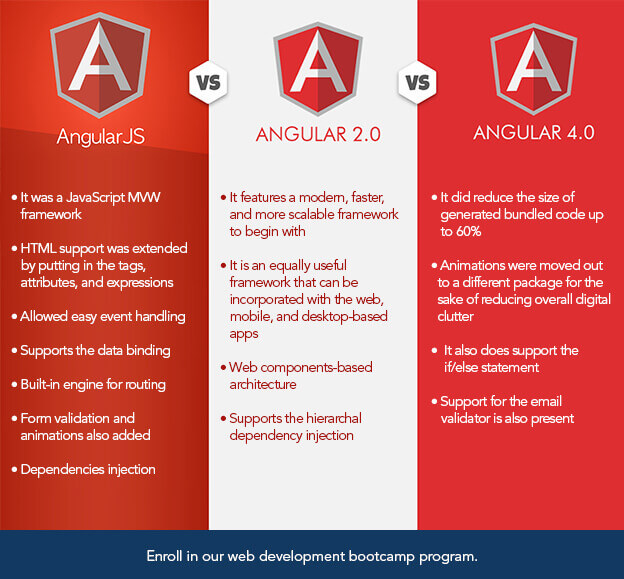
Angular JS vs Angular 2 vs Angular 4: Know the Differences
If you happen to be in the web development business then you already know the pace at which the technologies tend to change. If there is a new improvement made to a particular software or tool then its newer version would be adapted almost instantly. Innovation is of the essence here and whenever it is applied to standard software and its new version has been put into the market the industries using the software have to comply with it and change accordingly. Angular JS which is an extremely popular web development tool for the front-end framework was first created by Google and made its debut in the international market in 2012.
It was the future of the HTML and effectively covered the downfalls associated with the web development language and effective use of libraries was also put to test, it is something that was never done before. But the original work on the Angular JS got started as earlier as 2009 and it is that version of the Angular JS that built the foundation of the present-day front-end web development framework. Gradually with the growth of the hype built around this dynamic front-end web application framework, the demand started to grow so did the idea of rolling out better updates and security patches for ambient performance in the form of newer versions was developed.

Features of the original Angular JS;
- It was a JavaScript MVW framework
- HTML support was extended by putting in the tags, attributes, and expressions
- Allowed easy event handling
- Supports the data binding
- Built-in engine for routing
- Form validation and animations also added
- Dependencies injection
This covers up all the relevant information that you need on the Angular JS 1, moving on we have other imperatives of Angular JS that will be discussed next.
What is Angular JS 2?
After the successful release of the Angular JS, the time moved forward and released the Angular JS 2 which was a major update of its time that was done to the front-end web application framework. It is solely based on the concepts of components based rendering of the various sections of the website such as coding/programming, design as well as the mechanics of the website. The typescript was used by the Angular JS 1 team and the second version was written completely from scratch and it also offered better and stronger performance to the web developers.
Many new features and tweaks were added within this build of the Angular JS systems such as;
- It features a modern, faster, and more scalable framework to begin with
- It is an equally useful framework that can be incorporated with the web, mobile, and desktop-based apps
- Web components based architecture
- Supports the hierarchal dependency injection
Why there was no Angular 3?
Angular 2 has been a single repository which means that each and every package needed to be downloaded from a router. These router packages mistakenly were called version 3 so that is why the development team skipped version 3 of the framework altogether and settled with the Angular 4. It was done in trials of maintaining the compatibility with the Angular Router's version.
Enroll in our coding bootcamp for fast-paced learning experience to become a skilled web developer.
What is Angular 4?
Angular 4 is a web application framework for building JavaScript applications. It does support the typescript, which without any doubt complies with JavaScript and displays the same name within the browser. It also does provide a navigation toolbar, auto-complete, menus, and other variety of features that are put together for the sake of increasing the UI of the app/tool. Unlike Angular 2 which was a completely rewritten version of the Angular 1, it is not rewritten in any sense but is upgraded from its previous version into the current setting.
Features of the Angular 4
- It did reduce the size of generated bundled code up to 60%
- Animations were moved out to a different package for the sake of reducing overall digital clutter
- It also does support the if/else statement
- Support for the email validator is also present
This is all there is to know about Angular 1, 2, and 4 all else are the revisions and features that these tools have in common. But if you are interested in the overall difference all of these have with themselves then again you have come to the right place. Following is a detailed set of differences that exists between Angular JS and Angular are stated below where Angular directs to 2 and 4 simultaneously.
Read more: Why Should Future Web Developers Learn Angular? Convincing Reasons
-
Architecture
Angular JS
The overall architecture for this version of the Angular JS is based on the model view controller design or MVC. This model is the central component that can express the application’s behavior and manage its data, logic along with the rules. It will generate an output that is based on the information fed into the model. The controllers would accept the input and convert it into commands for sending them to the model and view.
Angular
In this version, the controllers and scope were replaced with components and directives. Components are the directive with a template. They deal with the overall design of the application and logic onto the page. Two different kinds of directives are being used within Angular 2.
-
Language
Angular JS
It is simply written in JavaScript.
Angular
It uses Microsoft's Typescript language and brings about tons of new features and benefits passed on to the user. It serves with combined advantages such as declarations and the benefits of the ES6 like iterations and lambdas.
-
Expression syntax
Angular JS
In order to bind any image or the property with a particular event of the Angular, you would have to remember the right ng directive there is.
Angular
Angular focuses on “( )” for event binding and “[ ]” for property binding.
- Mobile support
Angular JS is the simple iteration of the program and was not built with mobile support in mind. While the Angular systems are compatible with mobile support and development.
- Routing
AngularJS uses $routeprovider.when() to configure routing while Angular uses @RouteConfig{(…)}.
Performance
The original purpose behind the development of the Angular JS was to provide technical aid to the designers and not the developers. Although a few improvements were done into the design of the Angular JS they were not enough to fulfill the developer requirements. The later versions, Angular 2 and 4 have been also upgraded to provide an overall improvement into the development, performance, agility, security as well as dependency injection related systems provided by the Angular front end web development framework.
- Speed
With the help of features such as 2-way binding, Angular JS gradually reduced the development effort and time. However, by creating more processing on the client-side, page load was taking some considerable time. Angular 2 provides a better structure to more easily create and maintain big applications and better change the detection mechanism. Angular 4 is the fastest version of all the Angular JS versions yet.
- Dependency injection
Angular also implements a unidirectional tree-based change detection and uses the Hierarchical dependency injection framework. This will significantly boost the overall performance of the framework that you are currently working on.
Popularity for the Angular systems (2 and 4) is on the rise
As you already know that Angular is a Google-based framework and for that very reason it supports a robust versioning model. The Angular team behind the curtains is working restlessly to fix bugs, improve the overall functioning of the Angular system, and sorting out technical problems faced by the users.
Also, you can come to speed with all the latest features that are going to be released in the next update so that you can start to modify your setup accordingly. These updates don't launch on your head as a surprise out of the blue, you would have enough time to understand what's coming your way and then prepare for it accordingly. As Angular 4 is the latest version that is being incorporated in various industries and organizations out there and offers these below-mentioned benefits that are nothing but a treat for the developers;
Code generation
Angular can help you to transform your template into the code that is highly scalable and can be integrated for today’s JavaScript virtual machines, helping you to merge the advantages of handwritten code with the productivity of the frameword
Code splitting
The new component router that is placed within the new Angular 4 helps in the automatic splitting of the code so that the users would only have to load the requisite code for rendering the view that they request. This way the loading speed for various angular apps could be increased. Angular is using modern web platforms to deliver an app-like experience right there on your web browser.
If you want to become an Angular professional then it is recommended that you join a dedicated web development boot camp where you can have effective training and professional.
Connect with our experts to know how you can learn more to start or advance your career in web development!
